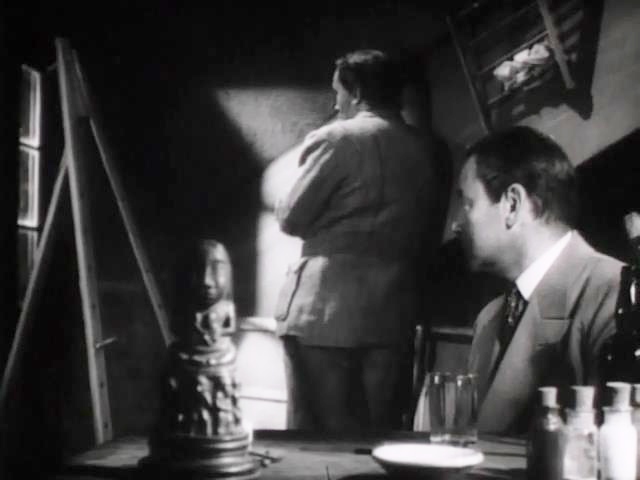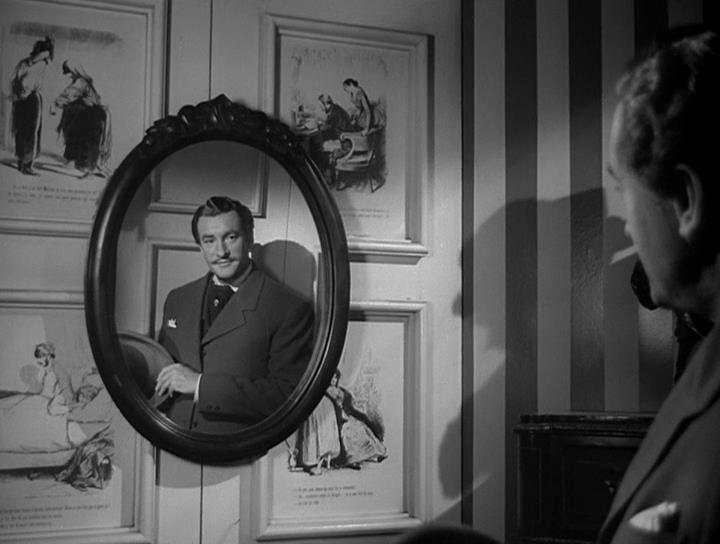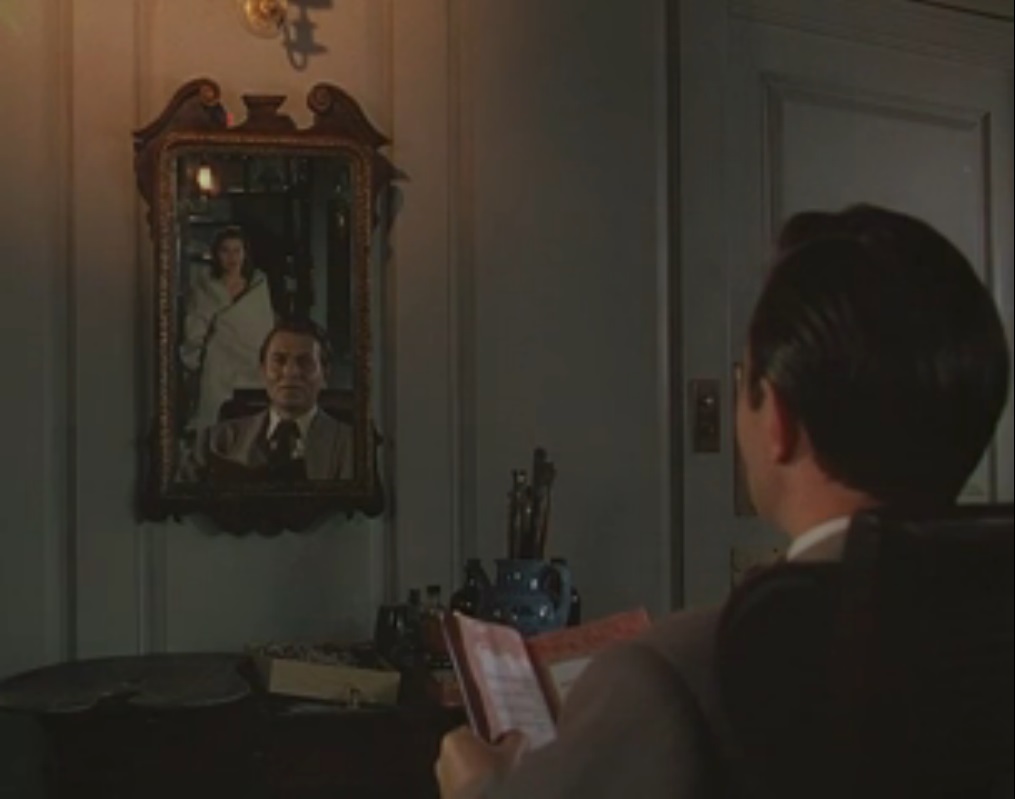The
Moon and Sixpence

The artist and
his biographer, they are not Gauguin and Maugham but one Strickland and a
certain Wolfe.
The great work is
a holocaust to “pride and contempt”, there is no place on Earth for
it, “the ugliness of his life finally destroyed him,” says a title,
concluding the film.
Strickland has run through London and Paris and
Marseilles, Tahiti is his home.
Wolfe has a portly valet who groans picking up after
him, and a perfectly normal sense of the proprieties (he thinks Strickland hath
a devil in him), the artist describes himself as a man in the water who must
somehow swim.
Lewin exercises the most brilliant technique to
achieve the design of his work, a vague resemblance to
the real persons has been noted.
“It was as if I were present at the beginning
of the world.”
The problems of painting are not those of literature
and film, though a similarity exists. Ken Russell takes perfect cognizance of
this. Max Brod refused to burn Kafka’s works,
and so we have “the secret king of German prose” (Nabokov).
Bosley Crowther of the New York Times contributed a prize piece
of imbecility on “the popular conception of a genius”. Variety praised the direction as
“keenly intelligent.” Geoff Andrew (Time Out) finds “unusually sophisticated Hollywood
entertainment.” Hal Erickson (All
Movie Guide), “extraneous exotica.” Leonard Maltin,
“surprisingly adult”. Halliwell’s
Film Guide, “a little stodgy”.
The Picture of Dorian Gray

It will readily
be seen that a trilogy is formed with The
Moon and Sixpence and The Private
Affairs of Bel Ami, or rather that they are the
same theme in three views.
It is equally
obvious that the question raised by Maugham for his own purposes is answered
explicitly by Wilde, the famous prescription that the Life or the Art might be beautiful, Maupassant considers the nature of the problem.
The repetition of
scenes and material, even actors, from one film to another is a particular
constant.
Bosley Crowther of the New
York Times, “one might venture to slip it a ribald razz.” Variety,
“interesting experiment.” Geoff Andrew (Time Out), “generally underrated”. Leonard
Maltin, “haunting”. TV Guide, “subtle and
frightening”. Hal Erickson (All
Movie Guide), “fascinating”. Halliwell’s Film Guide,
“elegant variation on Dr Jekyll and
Mr Hyde,” citing James Agee and Richard Winnington to no purpose.
“I confess, I never could resist Lady Agatha’s
quail.” A great and terrible work.
The Shooting Party (dir. Alan Bridges) remembers the hunting
accident. The final scene recalls Citizen
Kane, as some writers have noted.
The Private Affairs of Bel Ami

“This is
the history of a scoundrel,” the modern Punch.
A work almost
frightening in its sublimity, a reader of Maupassant, Lewin, his key work, a
successful analysis of The Moon and
Sixpence as a close variant.
Metty
cinematography, Milhaud score, Aldrich assisting the director, Milhaud
conducting.
It is very
profitable to Jacques Becker (Les Amants de Montparnasse),
“now is the time to buy. The painters are all starving. They’ve not
a sou!” The painting of all
paintings, Ernst’s The Temptation
of St. Anthony, in Technicolor. “Yes,” says Bel Ami looking at it. Certain lessons of Welles are well
taken.
“I could
have been happy with Clotilde,” says Bel Ami, the essential paradox. He is a journalist, what
says the profession? According to Bosley Crowther
of the New York Times, “really,
it is incredible that a picture could be made from a Guy de Maupassant novel
and be as tiresome as this. But there’s no denying the
evidence,” which in his view is Lewin’s responsibility “who
not only directed but wrote the screen play” though he did not create the
“downright nauseous” painting. Variety
was bogged down by the novel, “cast is exceptionally strong and, under
Lewin’s skilled direction, is mostly responsible for the film’s
merits.” Tom Milne (Time Out)
neglects to understand it, “if there is a villain it is a society
so” blah blah blah, “a sadly neglected film.” According
to Leonard Maltin, “delicious, literate”.
Hal Erickson (All Movie Guide) finds
“esoteric story material” and a “fascination with Egyptian
sculpture and feline symbolism.” Halliwell’s
Film Guide, “tame and stuffy”.
Pandora and the Flying
Dutchman

The structure is profoundly
simple, a one-two-three punch and then a magnification of it with the
introduction of a torero who meets his match, and it serves from first
to last as a Khayyam exegesis.
The thought is
elaborate and extremely fine, like the production, the writing and the filming.
“Pandora
Reynolds, of Indianapolis and points east” meets the honest-to-goodness fliegende
Holländer in Esperanza, Spain after watching a sot kill himself for her,
and another suitor push his racing car over a cliff to satisfy her.
The torero
injects a scene of comedy and a welcome analysis, the Dutchman cannot be
killed, that is the curse. The torero, stupefied at seeing his rival
stride into the toreo after several knife wounds in the back, stands
stock-still and is gored.
The racing car
driver sets a new land speed record on the beach at Esperanza, even with the
engine on fire.
Initially, the
critical response was rather poor (Time, New York Times, Variety),
it has now somewhat improved.
Khayyam’s Moving Finger reveals finally its identity with
Shakespeare’s “this gives life to thee.”
Saadia
In Morocco, a
tale of the old witch and her superstitions practiced upon a young woman, a Parisian doctor fights for her.
The charms of this
are so patent they are a well of understanding, a certain allure of Robert
Wise’s The Haunting and still
more of Jimmy Sangster’s Lust for a
Vampire is at the heart of the structure, a formidable construction for a
volatile analysis.
Tribal hostility is
another factor. A plague on the people is a blessing to cutthroats. Lewin
ironically cites The Sheik (dir.
George Melford) the better to turn the title character into a Biblical heroine.
It is certainly a
work of genius. “The head of a gazelle” for a Parisian
fireplace, or the wife of the Caid.
“Handsome
but hopeless”, said Bosley Crowther of the New York Times, “the screenplay is terrible... a model of
dramatic non sequiturs,” etc.
Tom Milne in Time Out Film Guide is caught short,
“Lewin’s weakest film.” Halliwell’s
Film Guide gives out that it is “pretentious and
ill-considered”.
The Living Idol
“The most
startling discovery in the whole of Mexican archæology,” a stone jaguar
in a pyramid, a gassy girl strangely affected by the sight of it, Juanita.
In Baudelairean
terms, the title needs no explanation.
“Superstition
is the name that science gives to truth.”
The jaguar god, the jaguar cult, all in a folded tortilla, believe it.
Dance of skirts
and gentlemen, fiesta (Eastman Color by Jack Hildyard, score by Rodolfo Halffter).
The
jaguar at the fiesta, with his tail between his legs.
“The
disease of our time, which believes in flying saucers and has no faith.”
The
director’s formidable genius takes him to Mexico City after off-camera
journalistic exploits in Korea delay the action.
Metempsychosis,
Mayan mythology, Tourneur and Wise, “the problem of evil” stated
from Blake’s Tyger, “a magnificent poem,
the most profound in the language, perhaps in any language.”
Samuel
Fuller’s Tigrero,
the missing link. A lecture on human sacrifice. A theory of
art. Apotheosis of Christianity. A paradox of culture.
“Nothing
worth explaining can be explained,” says the archæologist.
Far
less than this would have nonplussed Bosley Crowther
of the New York Times, “esoteric,
incomprehensible and absurd.”
Halliwell’s Film Guide seconds that, “but rather enjoyable”.